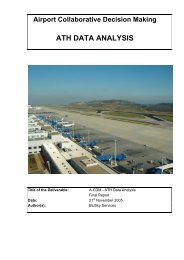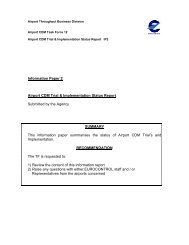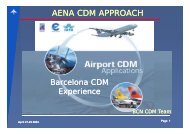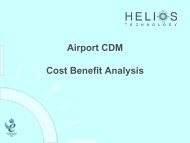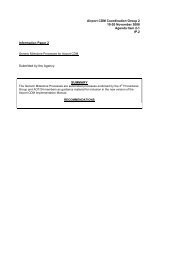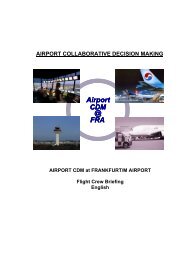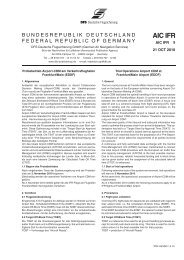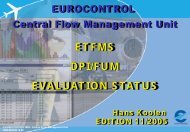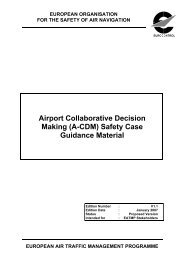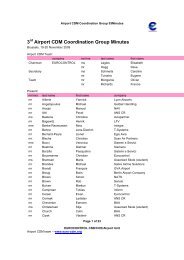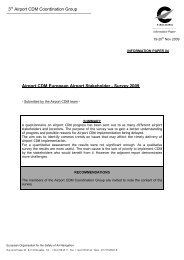Integration of A-SMGCS and DMAN Workshop 2 (12-13 June 2008)
Integration of A-SMGCS and DMAN Workshop 2 (12-13 June 2008)
Integration of A-SMGCS and DMAN Workshop 2 (12-13 June 2008)
You also want an ePaper? Increase the reach of your titles
YUMPU automatically turns print PDFs into web optimized ePapers that Google loves.
MoM <strong>of</strong> <strong>DMAN</strong> A-<strong>SMGCS</strong> <strong>Workshop</strong> <strong>12</strong>-<strong>13</strong> <strong>June</strong> <strong>2008</strong><br />
Minutes <strong>of</strong> Meeting<br />
<strong>Integration</strong> <strong>of</strong> A-<strong>SMGCS</strong> <strong>and</strong> <strong>DMAN</strong>, <strong>Workshop</strong> 02<br />
Eurocontrol HQ Brussels, Meeting Room Mercure / Neptune, <strong>12</strong>-<strong>13</strong> <strong>June</strong> <strong>2008</strong><br />
Organiser: Airport Operations & Environment (AOE) Division<br />
1. Agenda<br />
Day 1<br />
10.00 Welcome <strong>and</strong> Introduction (Klaus Haschke, EHQ)<br />
10.20 Summary <strong>of</strong> Eurocontrol’s discussions with<br />
Industry during ATC Global <strong>2008</strong> on <strong>DMAN</strong>/A-<strong>SMGCS</strong> integration<br />
<strong>and</strong> CDM definitions (Kim Sil<strong>and</strong>er, EHQ)<br />
10.40 Topic 1: De-icing<br />
Questions in connection with de-icing (Dr. Dietmar Böhme, DLR)<br />
Discussions<br />
11.20 C<strong>of</strong>fee break<br />
11.40 H<strong>and</strong>ling <strong>of</strong> de-icing in Arl<strong>and</strong>a (Jan-Ol<strong>of</strong> Roos, LFV)<br />
Discussions<br />
<strong>12</strong>.30 Lunch break<br />
<strong>13</strong>.30 Importance <strong>of</strong> Sequencing<br />
under Adverse Conditions (Henk Hesselink, NLR)<br />
14.20 Topic 2: Target Based Behavior<br />
Explaining the problem (Eugene Tuinstra, EHQ)<br />
Discussions<br />
16.00 Summary & End <strong>of</strong> Meeting Day 1 (Klaus Haschke, EHQ)<br />
Day 2<br />
10.00 Welcome <strong>and</strong> Introduction (Klaus Haschke, EHQ)<br />
10.15 ASMAS Overview (Paul Adamson, EHQ)<br />
10.30 Summary <strong>of</strong> <strong>Workshop</strong> 1 (Kim Sil<strong>and</strong>er, EHQ)<br />
Summary <strong>of</strong> <strong>Workshop</strong> Day 1 (Eugene Tuinstra, EHQ)<br />
11.00 Comments from the Industry / Discussions<br />
11.30 C<strong>of</strong>fee break<br />
11.50 Discussions on Definition <strong>and</strong> Characteristics <strong>of</strong> <strong>DMAN</strong><br />
<strong>DMAN</strong> definition (Kim Sil<strong>and</strong>er, EHQ)<br />
A-CDM definition (Eugene Tuinstra, EHQ)<br />
<strong>12</strong>.10 Comments from the Industry / Discussions<br />
<strong>12</strong>.30 Lunch break<br />
<strong>13</strong>.30 Requirements for TRS (Klaus Haschke, EHQ)<br />
<strong>13</strong>.45 Plans for launching TRS for Validation (Paul Adamson, EHQ)<br />
14.00 Wrap up (Klaus Haschke, EHQ)<br />
14.30 End <strong>of</strong> <strong>Workshop</strong><br />
Page 1 <strong>of</strong> 14<br />
EUROCONTROL Airport Operations & Environment Division
2. Participants<br />
MoM <strong>of</strong> <strong>DMAN</strong> A-<strong>SMGCS</strong> <strong>Workshop</strong> <strong>12</strong>-<strong>13</strong> <strong>June</strong> <strong>2008</strong><br />
Function Last name First name Initials Email Address Organisation<br />
Chairman: Haschke Klaus KH Klaus.Haschke@eurocontrol.int EUROCONTROL / AOE<br />
Secretary: Tuinstra Eugene ET Eugene.Tuinstra@eurocontrol.int EUROCONTROL / AOE<br />
Present:<br />
Sil<strong>and</strong>er Kim KS Kim.Sil<strong>and</strong>er@eurocontrol.int EUROCONTROL / AOE<br />
Adamson Paul<br />
PA Paul.Adamson@eurocontrol.int<br />
EUROCONTROL / AOE<br />
Schmeits Caroline<br />
CS Caroline.schmeits@eurocontrol.int<br />
EUROCONTROL / AOE<br />
Tempelaar Vincent<br />
VT Vincent.tempelaar@eurocontrol.int<br />
EUROCONTROL / AOE<br />
Dubuisson Stephane<br />
SD Stephane.Dubuisson@eurocontrol.int<br />
EUROCONTROL / EEC<br />
Lane Roger<br />
RL Roger.Lane@eurocontrol.int<br />
EUROCONTROL / EEC<br />
Huck Volker<br />
VH Volker.Huck@eurocontrol.int<br />
EUROCONTROL / ATS<br />
Berry Marie-Louise<br />
LB Marie-louise.berry@eurocontrol.int<br />
EUROCONTROL / AOE<br />
Posern Roy<br />
RP R.Posern@fraport.de<br />
Fraport<br />
Boettcher Steffen<br />
SB S.boettcher@fraport.de<br />
Fraport<br />
Boehme Dietmar<br />
DB Dietmar.Boehme@dlr.de<br />
DLR<br />
Greenwood John<br />
JG John.Greenwood@nats.co.uk<br />
NATS<br />
Becker Rol<strong>and</strong> B.<br />
RB Rol<strong>and</strong>.Becker@unique.ch<br />
Unique (Flughafen Zürich AG)<br />
Woborsky Christian<br />
CW Christian.Woborsky@austrocontrol.at<br />
Austro Control<br />
Cermak Ladislav<br />
LE Ladislav.Cermak@ans.cz<br />
ANS CR Prague<br />
Roos Jan-Ol<strong>of</strong><br />
JR jan-ol<strong>of</strong>.roos@lfv.se<br />
LFV Group<br />
Wall Åke<br />
ÅW Ake.Wall@lfv.se<br />
LFV Group<br />
Dhaenens Stefaan<br />
SD Stefaan_dhaenens@belgocontrol.be<br />
Belgocontrol<br />
Matthys Marc<br />
MM Mam@belgocontrol.be<br />
Belgocontrol<br />
Sterckx Marc<br />
MS Marc_sterckx@belgocontrol.be<br />
Belgocontrol<br />
Teotino Daniele<br />
DT dteotino.sicta@enav.it<br />
ENAV<br />
Nuzzo Antonio AN anuzzo@enav.it<br />
ENAV<br />
Flick Marcel<br />
MF info@flickaviation.com<br />
Flick Aviation<br />
Moutinho Joao<br />
JM Joao.moutinho@eurocontrol.int<br />
Eurocontrol / TAP<br />
Hesselink Henk<br />
HH hessel@nlr.nl<br />
NLR<br />
Dongen, v. Annemieke<br />
AD Dongen@lnr.nl<br />
NLR<br />
Page 2 <strong>of</strong> 14<br />
EUROCONTROL Airport Operations & Environment Division
Hatzack Wolfgang<br />
Eisele Michael<br />
Nga Bui<br />
Lionel Bernard-P.<br />
Decsi Tom<br />
Wiesner Martin<br />
Carozzo Aless<strong>and</strong>ro<br />
Ponfiri Stefano<br />
Kunz Stefan<br />
Chan Terence<br />
Lin Kelvin<br />
MoM <strong>of</strong> <strong>DMAN</strong> A-<strong>SMGCS</strong> <strong>Workshop</strong> <strong>12</strong>-<strong>13</strong> <strong>June</strong> <strong>2008</strong><br />
WH<br />
ME<br />
BN<br />
BL<br />
TD<br />
MW<br />
AC<br />
SP<br />
SK<br />
TC<br />
KL<br />
Wolfgang.hatzack@atrics.de<br />
Michael.eisele@barco.com<br />
Nga.bui@egis.fr<br />
Lionel.bernard-peyre@egis.fr<br />
Tom.decsi@eurocontrol.int<br />
Martin.wiesner@delair.de<br />
acarrozzo@selex-si.com<br />
sporfiri@selex-si.com<br />
s.kunz@avibit.com<br />
Terence@linfair.net<br />
Kelvin@linfair.net<br />
Page 3 <strong>of</strong> 14<br />
Atrics<br />
Barco<br />
EUROCONTROL Airport Operations & Environment Division<br />
Egis<br />
Egis<br />
EUROCONTROL / ATS<br />
Delair<br />
Selex<br />
Selex<br />
Avibit<br />
Linfair<br />
Linfair<br />
3. Welcome <strong>and</strong> Introduction (Klaus Haschke, Eurocontrol)<br />
Klaus Haschke (KH) opened the meeting at 10.00 hrs, welcomed all participants, presented<br />
the agenda <strong>and</strong> mentioned the objective for Day 1, which was:<br />
• Exchange knowledge on <strong>DMAN</strong> <strong>and</strong> A-<strong>SMGCS</strong>, with special focus on de-icing<br />
• Discuss Target Based Behavior from A-CDM <strong>and</strong> SESAR point <strong>of</strong> view<br />
An introduction round <strong>of</strong> all the participants followed.<br />
Copies <strong>of</strong> the Minutes <strong>of</strong> Meeting from WS1 <strong>of</strong> 22.02.08 <strong>and</strong> an information paper<br />
”<strong>Integration</strong> <strong>of</strong> A-<strong>SMGCS</strong> Level 1 <strong>and</strong> <strong>DMAN</strong>” were made available for newcomers.<br />
Note: All meeting minutes below end with discussion, where Q st<strong>and</strong>s for Question;<br />
A st<strong>and</strong>s for Answer; R st<strong>and</strong> for Remark.<br />
4. Summary <strong>of</strong> Eurocontrol’s Discussions with the Industry (Kim<br />
Sil<strong>and</strong>er, Eurocontrol)<br />
In March <strong>2008</strong> during the Global ATC exhibition in Amsterdam several industrial partners<br />
were visited at their st<strong>and</strong>s in order to gain feedback on <strong>DMAN</strong> <strong>and</strong> A-<strong>SMGCS</strong> need for<br />
interface st<strong>and</strong>ards, as well as to inform them on Airport CDM as basic requirement for<br />
acronyms, procedures <strong>and</strong> exchange with CFMU Departure Planning Information (DPI)<br />
messages. Meetings were positive <strong>and</strong> informative. Industry reacted by strong presence on<br />
day 2 <strong>of</strong> this workshop.
MoM <strong>of</strong> <strong>DMAN</strong> A-<strong>SMGCS</strong> <strong>Workshop</strong> <strong>12</strong>-<strong>13</strong> <strong>June</strong> <strong>2008</strong><br />
Discussions:<br />
Q: Why is AMAN not part <strong>of</strong> the roadmap in Eurocontrol? <strong>DMAN</strong>-AMAN seems to<br />
many industry <strong>and</strong> partners an important next step? Boundaries between <strong>DMAN</strong>-AMAN<br />
should be visualised <strong>and</strong> defined.<br />
A: The rational for this approach is that to enable proper sequencing using mixed<br />
mode with tailored gaps you need absolute predictability <strong>of</strong> the outbound taxi flow at the<br />
runway. Hence <strong>DMAN</strong> <strong>and</strong> A-<strong>SMGCS</strong> is a first step that may identify how predictable the<br />
outbound really can be. This may give underst<strong>and</strong>ing <strong>of</strong> how much uncertainty needs to be<br />
buffered for AMAN-<strong>DMAN</strong> operations in future.<br />
Q: Are buffer length at the runway holding considered? These should be shortened<br />
from an airline perspective.<br />
A: The queues should be reduced, however from a capacity point <strong>of</strong> view one needs to<br />
feed the runway in order not to waste runway slots. Hence, depending on ATC policy <strong>and</strong><br />
controller preference a minimum average amount <strong>of</strong> aircraft should be in the runway buffer<br />
to feed the throughput.<br />
Q: <strong>DMAN</strong> <strong>and</strong> network objectives, is Industry aware <strong>of</strong> the network objectives in<br />
SESAR that can be met with <strong>DMAN</strong>?<br />
A: That is why industry is involved in this workshop on day 2.<br />
5. Questions in connection with De-icing (Dietmar Boehme, DLR)<br />
Dietmar Boehme (DB) explained the consequences for taxi time estimations when de-icing<br />
is applied. Three types <strong>of</strong> de-icing are identified:<br />
• At st<strong>and</strong><br />
• After long pushback<br />
• Remote<br />
De-icing at the st<strong>and</strong> is not affecting the taxi out time, but can give uncertainties to the<br />
TOBT prediction. A long pushback affects the taxi time, however is fairly predictable due to<br />
direct availability <strong>of</strong> the de-icing equipment. Remote de-icing is highly unpredictable due to<br />
the taxi time to the remote area, the uncertainty <strong>of</strong> the waiting time before de-icing due to<br />
other aircraft, <strong>and</strong> the complexity factor <strong>of</strong> the de-icing depending on weather conditions.<br />
Important factors with de-icing are the holdover time, which is the time window where the<br />
aircraft must take-<strong>of</strong>f before the effect <strong>of</strong> de-icing is lost. This holdover time is a crucial<br />
constraint for pilots, <strong>and</strong> is directly affecting safety.<br />
Another factor with remote de-icing is that propeller <strong>and</strong> wide body aircraft need to shut<br />
down the engines during de-icing. However this may be a local issue for some airports,<br />
depending on their local procedures <strong>and</strong> laws.<br />
Adding to the unpredictability <strong>of</strong> de-icing times is the fact that some aircraft in the sequence<br />
for the runway have remote de-icing whilst others have de-icing at gate or after push back.<br />
Also the required de-icing method <strong>and</strong> mixture, based on temperature, dew point <strong>and</strong> icing<br />
condition <strong>of</strong> the aircraft, results in uncertainties for the de-icing duration.<br />
Page 4 <strong>of</strong> 14<br />
EUROCONTROL Airport Operations & Environment Division
MoM <strong>of</strong> <strong>DMAN</strong> A-<strong>SMGCS</strong> <strong>Workshop</strong> <strong>12</strong>-<strong>13</strong> <strong>June</strong> <strong>2008</strong><br />
The impact <strong>of</strong> de-icing on sequencing is complex. Instable weather with changing de-icing<br />
dem<strong>and</strong>s from pilots has impact on the estimation <strong>of</strong> the duration, as well as the holdover<br />
time. Stable conditions however may prescribe more equal types <strong>of</strong> de-icing, <strong>and</strong> hence the<br />
process can be better estimated.<br />
Estimations depend on whether the de-icing procedure becomes a new bottleneck. If this is<br />
the case due to resource limitations, the runway throughput will always suffice, <strong>and</strong> waiting<br />
times in runway buffers do not exist. However, when de-icing has enough resources<br />
available, the runway could become the bottleneck resulting in problems for de-iced flights<br />
with limited holdover time. Prioritisation may then be critical in sequence building, hence,<br />
intelligent de-icing <strong>and</strong> runway sequencing becomes essential. Impact <strong>of</strong> ATFM slots in<br />
combination with de-icing or adverse conditions may be a topic for investigation by the<br />
Airport CDM team, as they are responsible for initiating procedures based on their<br />
implementation manual.<br />
De-icing may require a separate sequencing, where <strong>DMAN</strong> for TSAT <strong>and</strong> TTOT<br />
calculations depend on. However, the main question with de-icing is how to get the<br />
information <strong>of</strong> the duration correct; how to get holdover time into the system, <strong>and</strong> how to<br />
reason with uncertainties in the predicted values. It is agreed that today’s figures are highly<br />
inaccurate, however it is also mentioned that a grip on the uncertainties is much desired to<br />
create more predictability in take-<strong>of</strong>f times. And this happens to be also a hard requirement<br />
from the SESAR project <strong>and</strong> CFMU; to have more predictability under adverse conditions,<br />
such as de-icing weather.<br />
Discussions:<br />
R: ETOT today in Airport CDM means Estimated Take-Off Time, <strong>and</strong> not Earliest<br />
Take-Off Time.<br />
R: It is essential to feed any planning system with de-icing capacity figures, which are<br />
output from the ground h<strong>and</strong>ler resource planning.<br />
R: How to get accurate de-icing information from the ground h<strong>and</strong>ler is the key<br />
problem. How to get the information into the Airport CDM system is even more problematic.<br />
The same accounts for the accurate holdover time. Pilots will know this only after de-icing,<br />
<strong>and</strong> a revised prediction <strong>of</strong> the TTOT is then already very late to anticipate as the holdover<br />
time may be very short.<br />
R: Information given by the ground h<strong>and</strong>ler may be inaccurate, <strong>and</strong> hence creates<br />
false expectations. To remain reliable no information or planning may be <strong>of</strong> more value<br />
then to make a poor planning which will be controversial. Poor planning may be especially<br />
the case in unstable weather situations with highly changing conditions <strong>and</strong> de-icing<br />
dem<strong>and</strong>s.<br />
A: The situation <strong>of</strong> highly instable weather is at most 10-15 days per annum. For all<br />
other de-icing conditions it makes very well sense to gather information <strong>and</strong> feed planning<br />
systems, as stable de-icing is not problematic to predict <strong>and</strong> use in <strong>DMAN</strong> runway planning.<br />
Default values based on statistics are more right then using no values <strong>and</strong> leave everything<br />
as is today.<br />
A: Fixed times for de-icing may not work, as different pilots have different dem<strong>and</strong>s <strong>of</strong><br />
de-icing factors. This may affect planning strongly, as holdover times will vary. And a pilot<br />
will never risk take <strong>of</strong>f outside their calculated holdover time as this is a critical safety issue.<br />
TTOT calculated by <strong>DMAN</strong> will not change the pilot’s behaviour as safety is priority.<br />
However it may be a burden to know under stressed conditions.<br />
A: <strong>DMAN</strong> enables a change in buffer times, in order to accommodate strict holdover<br />
times. It is however important to get the holdover time into the system, <strong>and</strong> this information<br />
Page 5 <strong>of</strong> 14<br />
EUROCONTROL Airport Operations & Environment Division
MoM <strong>of</strong> <strong>DMAN</strong> A-<strong>SMGCS</strong> <strong>Workshop</strong> <strong>12</strong>-<strong>13</strong> <strong>June</strong> <strong>2008</strong><br />
is not always known today. Usually only in the case the pilots have problems or are close to<br />
the end <strong>of</strong> the holdover time they communicate this to ATC. This may be the case when the<br />
runway is swept <strong>and</strong> de-iced aircraft are waiting to take-<strong>of</strong>f.<br />
R: Information on holdover time must always be reported by radio communication, as it<br />
is critical information which must be understood <strong>and</strong> confirmed by ATC directly to the pilot.<br />
Data link would not be an appropriate medium to enter this type <strong>of</strong> information, as it is<br />
safety critical <strong>and</strong> urgent information. Closed loop communication is essential for safety<br />
critical messages.<br />
Q: When is <strong>DMAN</strong> planning the TSAT <strong>and</strong> TTOT sequences, when is information<br />
available to sequence?<br />
A: Hours in advance already information is available, such as CTOT, EOBT, <strong>and</strong> from<br />
CFMU Flight Update Messages (FUMs) information on outstation take-<strong>of</strong>f (ATOT) <strong>and</strong><br />
hence Estimated L<strong>and</strong>ing Time (ELDT). This information, coming from a well implemented<br />
Airport CDM Milestone process, is refining <strong>DMAN</strong> predictions <strong>and</strong> will become even more<br />
accurate after in-blocks, when TOBT updates are made by Ground H<strong>and</strong>ler or Aircraft<br />
Operator, depending on progress in the turn-round process. Once TSAT is issued based on<br />
TOBT predictions <strong>and</strong> traffic constraints, the planning should become stable. After <strong>of</strong>f<br />
blocks the controllers may deviate from the planned sequence if it is tactically required. Via<br />
surveillance or electronic strip inputs, the planning can be adjusted to the actual events that<br />
cause lost or gained time in the planning.<br />
Q: Can the pilot provide accurate information about the hold over time <strong>and</strong> end <strong>of</strong> deicing<br />
before commencing the actual de-icing?<br />
A: Yes, when we know the mixture <strong>of</strong> de-icing fluid we can provide this information. This is<br />
normally known before we start de-icing.<br />
R: A pilot proposed that before commencing de-icing, the pilot would provide ATC over<br />
radio with the expected de-icing <strong>and</strong> holdover time. This could to some extent be a<br />
mitigation to the uncertainty <strong>of</strong> remote de-icing situations since that can be fed to a<br />
<strong>DMAN</strong>/CDM process 5-10 minutes before the aircraft would leave the de-icing area.<br />
6. H<strong>and</strong>ling <strong>of</strong> De-icing in Arl<strong>and</strong>a (Jan-Ol<strong>of</strong> Roos, LFV)<br />
Jan-Ol<strong>of</strong> Roos (JR) presents the current de-icing operations at Stockholm Airport Arl<strong>and</strong>a.<br />
He confirms the three types <strong>of</strong> de-icing at st<strong>and</strong>, after pushback, or remote, mentioned<br />
earlier by DB. All three de-icing situations are applicable at Arl<strong>and</strong>a, <strong>and</strong> extra constraints<br />
are present due to environmental restrictions for the 3 rd RWY where all aircraft have to deice<br />
remotely. Another problem is the relocation <strong>of</strong> de-icing units in case <strong>of</strong> configuration<br />
change from remote to gate in the morning peak, which has negative impact on capacity.<br />
However it is basically only the remote de-icing that actually forms the main uncertainty in<br />
estimating taxi times. St<strong>and</strong> de-icing or after pushback predictions can be made more<br />
accurately (which is 60-70% <strong>of</strong> total flights).<br />
A detailed table <strong>of</strong> de-icing values is available which gives information <strong>of</strong> the expected<br />
duration for different de-icing complexities.<br />
Arl<strong>and</strong>a expects to incorporate de-icing into the <strong>DMAN</strong> planning, since it is essential for the<br />
future mixed mode operations to get control over the runway sequence predictions. It is<br />
planned to go into mixed mode operations already in 2009.<br />
Discussions:<br />
Page 6 <strong>of</strong> 14<br />
EUROCONTROL Airport Operations & Environment Division
MoM <strong>of</strong> <strong>DMAN</strong> A-<strong>SMGCS</strong> <strong>Workshop</strong> <strong>12</strong>-<strong>13</strong> <strong>June</strong> <strong>2008</strong><br />
Q: How can you know the de-icing complexity?<br />
A: It is not known today, this is a problem still to be resolved!<br />
Q: Is any study done to justify the de-icing duration values in the table?<br />
A: No, these are estimates <strong>of</strong> experts, but validation is essential to get these values<br />
more accurate. Also, uncertainty margins must be determined to reason with uncertainty.<br />
R: Today’s de-icing rates are highly unpredictable due to squeezing <strong>of</strong> statistics to<br />
unrealistic de-icing times. This is mainly caused by the competition between companies on<br />
the airport where coordination would be needed but is avoided due to this competition<br />
factor.<br />
R: Especially this competition is creating a big uncertainty factor that under adverse<br />
conditions should be mitigated. Measurements should be performed locally <strong>and</strong> delay<br />
codes adjusted to real causes. However <strong>of</strong>ten delay codes are not realistic <strong>and</strong> true causes<br />
may be covered up.<br />
A: De-ice sequencing is influenced by many factors. Refuelling <strong>of</strong> the trucks can cause<br />
delay in de-icing, especially when all trucks are empty at the same time, causing a queue <strong>of</strong><br />
trucks for refuelling. Information is not shared, which causes the aircraft queue to increases<br />
also.<br />
R: Some airports have procedures to shut down engines during remote de-icing.<br />
A: In that case extra start-up time is needed before aircraft re-commences taxi to<br />
runway. This is an additional 10 minutes for wide body aircraft.<br />
R: Additional taxi time may be also needed for slow taxi speed due to icy taxi ways.<br />
Often corners <strong>of</strong> the taxi ways are not swept as well as main taxiways or runways. This<br />
time loss is putting extra pressure on pilots to achieve take <strong>of</strong>f within the holdover time.<br />
A: However such time can be foreseen by modification <strong>of</strong> the variable taxi times due to<br />
bad weather or other conditions.<br />
Q: Have there been studies to justify remote de-icing versus st<strong>and</strong> de-icing?<br />
A: Environmental rules make remote de-icing for 3 rd RWY m<strong>and</strong>atory. Hence the<br />
remote platform is designed for large capacity de-icing in order to maintain high capacity<br />
runway operations during mixed mode runway use in 2009. Also mixed mode runway<br />
operations require less departures per runway, hence maximum capacity needed for mixed<br />
mode is lower then today’s segregated runway use. <strong>DMAN</strong> is expected to deliver a reduced<br />
taxi time <strong>of</strong> 50% under de-icing conditions. That is what justifies the work on <strong>DMAN</strong> <strong>and</strong> the<br />
integration <strong>of</strong> de-icing planning. This 50% equals 4-5 Tons per hour <strong>of</strong> fuel reduction <strong>and</strong><br />
hence environmental benefits.<br />
Q: Is queuing included into VTT? How is the VTT build up?<br />
A: Yes, VTT includes pushback <strong>and</strong> start-up manoeuvre, taxi movement time, runway<br />
buffer <strong>and</strong> line-up time. With de-icing, extra time <strong>and</strong> de-icing queues needs to be added<br />
which is discussed above.<br />
R: Low visibility procedures reduce taxi speed substantially.<br />
A: Hence, movement time should be increased. This can be done by adjusting the total<br />
taxi time for all aircraft, or just the taxi element that represents movement, so that longer<br />
taxi routes get corresponding extra taxi time.<br />
R: It is <strong>of</strong> absolute importance that actual de-icing times are fed back into the planning,<br />
the same way as actual events on runway or <strong>of</strong>f-blocks are fed back to update the planning<br />
<strong>and</strong> avoid drifting <strong>of</strong> plan versus reality. Robustness <strong>of</strong> planning starts with feeding it with<br />
actual events to measure time gains <strong>and</strong> losses.<br />
Page 7 <strong>of</strong> 14<br />
EUROCONTROL Airport Operations & Environment Division
MoM <strong>of</strong> <strong>DMAN</strong> A-<strong>SMGCS</strong> <strong>Workshop</strong> <strong>12</strong>-<strong>13</strong> <strong>June</strong> <strong>2008</strong><br />
7. Importance <strong>of</strong> Sequencing under Adverse Conditions (Henk<br />
Hesselink, NLR)<br />
Henk Hesselink (HH) presented the history <strong>of</strong> <strong>DMAN</strong> work in NLR, which goes back almost<br />
ten years <strong>and</strong> consists <strong>of</strong> research projects <strong>and</strong> simulation experiments. The concept <strong>of</strong><br />
<strong>DMAN</strong> is briefly explained, where flexible preference functions represent complex time<br />
constraints. With these preference functions every flight can be transformed into a flight<br />
pr<strong>of</strong>ile <strong>and</strong> an algorithm can calculate the optimal take-<strong>of</strong>f time for multiple flights with<br />
overlapping constraints.<br />
Currently NLR is working with Amsterdam Airport Schiphol to determine procedures for the<br />
Airport CDM subproject Collaborative Pre-Departure Sequence Planning, which is similar to<br />
<strong>DMAN</strong> objectives <strong>of</strong> runway <strong>and</strong> <strong>of</strong>f-block planning. A demonstrator tool is being developed<br />
to enable discussions by visualisation <strong>of</strong> scenarios <strong>and</strong> consequences <strong>of</strong> sequencing.<br />
An example is shown from a stormy day at Schiphol, when only one active runway was<br />
used <strong>and</strong> queues were caused by different priorities <strong>of</strong> flights (regulated versus nonregulated).<br />
The demonstrator can also incorporate a Take-<strong>of</strong>f Interval Rate, which could<br />
during adverse conditions increase the delays for non-regulated flights significantly.<br />
Discussions:<br />
Q: Which flights can be considered pre-departure sequenced?<br />
A: With different views <strong>of</strong> the demonstrator the flights that are sequenced becomes<br />
visible. The demonstrator is organised in a flexible manner to show different perspectives,<br />
e.g. for different users.<br />
Q: Why is TSAT frozen 15 minutes in advance?<br />
A: This is similar to the Arl<strong>and</strong>a <strong>DMAN</strong>; a certain period <strong>of</strong> stability is needed. When<br />
the TSAT would still change dynamically, resource planners <strong>of</strong> different users would not be<br />
able to anticipate efficiently. At Schiphol this stability period is minimally 15 minutes for<br />
mainly the Ground H<strong>and</strong>lers to organise <strong>and</strong> anticipate. However, discussions at Schiphol<br />
are still on-going.<br />
Q: How about de-icing at Schiphol?<br />
A: Also still ongoing discussions, similar to this workshop.<br />
Q: How does prioritisation <strong>and</strong> competition affect runway sequencing, when some<br />
airlines receive too much priority or benefits over other airlines? Will that generate legal<br />
conflicts in the future?<br />
A: Legal issues should be avoided by using Airport CDM procedures, <strong>and</strong> moreover a<br />
Memor<strong>and</strong>um <strong>of</strong> Underst<strong>and</strong>ing between all partners. This can be done by objective <strong>and</strong><br />
agreed measurement <strong>of</strong> actual <strong>and</strong> planned sequences, <strong>and</strong> evaluated on frequent basis<br />
with all partners. Goal is to improve the overall performance <strong>of</strong> an airport. It is the aim <strong>of</strong> the<br />
ANSP <strong>and</strong> all partners to have fewer delays <strong>and</strong> all aircraft operators benefit from more<br />
automation.<br />
8. Target Based Behavior (Eugene Tuinstra, Eurocontrol)<br />
Eugene Tuinstra (ET) presented the impact <strong>of</strong> Airport CDM <strong>and</strong> SESAR for pilots.<br />
Especially for this <strong>and</strong> regarding the de-icing discussed above, Pilots (Marcel Flick <strong>and</strong><br />
Joao Moutinho) <strong>and</strong> ground h<strong>and</strong>ler expert Caroline Schmeits were invited to the workshop<br />
Page 8 <strong>of</strong> 14<br />
EUROCONTROL Airport Operations & Environment Division
MoM <strong>of</strong> <strong>DMAN</strong> A-<strong>SMGCS</strong> <strong>Workshop</strong> <strong>12</strong>-<strong>13</strong> <strong>June</strong> <strong>2008</strong><br />
<strong>and</strong> their presence was much appreciated. They provided valuable insights <strong>and</strong><br />
explanations.<br />
The target based behavior presentation was conducted as a dialog between Eugene <strong>and</strong><br />
Joao, with Joao <strong>and</strong> Marcel contributing the pilot’s view. Airport partners mostly from ATC<br />
shared their thoughts which lead to an open discussion.<br />
Discussions:<br />
Q: What will the value be <strong>of</strong> a TOBT update by the pilot?<br />
A: A pilot may encounter situations on board after doors closed, which may justify an<br />
update via radio or data link.<br />
A: We may not forget the importance <strong>of</strong> the TSAT, being issued between 40 <strong>and</strong> 20<br />
Minutes before EOBT. This is to establish the pre-departure sequence. Only in case <strong>of</strong> late<br />
TOBT updates, after aircraft being ready, these can be taken into account.<br />
Q: How do we know that the Ground H<strong>and</strong>ling Agent will provide an accurate TOBT?<br />
They don’t want to be responsible for any delays for commercial reasons <strong>and</strong> so will be<br />
conservative in their TOBT updates.<br />
A: It is true that Airlines do blame <strong>and</strong>/or fine ground H<strong>and</strong>ling agents for delays. Also<br />
competition amongst them is responsible for ‘better performance’ on paper. So they will not<br />
be forced to review their resources. But as accurate TOBT input is providing benefits for the<br />
h<strong>and</strong>ler too, they are motivated to give quality information.<br />
Q: Who should have the responsibility for sending TOBT updates? Airlines, Ground<br />
H<strong>and</strong>lers or pilots?<br />
A: It was agreed that the ground h<strong>and</strong>ler has the most vital information for the<br />
accuracy <strong>of</strong> the updates, but there was a doubt on the honesty <strong>of</strong> these times. (See<br />
previous question) The Airlines are reluctant to give the authority <strong>of</strong> sending TOBT’s to the<br />
h<strong>and</strong>ler. This is <strong>of</strong>ten because <strong>of</strong> lack <strong>of</strong> knowledge, <strong>and</strong> they think these updates are the<br />
same as DLY (delay) messages on their flight plan. A pilot would have a more vested<br />
interest in providing accurate TOBT since it directly affects his own aircraft. No conclusions<br />
can be made on which procedure (pilot involvement or not) would result in more reliable<br />
TOBT updates. This needs to be addressed in future A-CDM studies.<br />
Q: Would the pilot change his behavior, for instance adjust taxi speed to meet the<br />
TTOT if this information would be made available?<br />
A: The pilot could work towards TTOT to some extent if safety is not compromised,<br />
e.g. during low visibility, slippery taxiway etc. However, there is also a risk that pilots stress<br />
to meet TTOT could result in safety hazards. This needs to be studied more in future<br />
activities before any conclusions can be made.<br />
R: Due to time constraints, other subjects like the linkage to SESAR could not be<br />
addressed.<br />
The workshop was continued on Day 2 with additional representatives from the Industry.<br />
The objective for Day 2 was:<br />
• Inform Industry on operational needs regarding planning<br />
• Outline <strong>of</strong> Eurocontrol’s <strong>DMAN</strong>/A-<strong>SMGCS</strong> Validation activities <strong>2008</strong> - 2010<br />
Page 9 <strong>of</strong> 14<br />
EUROCONTROL Airport Operations & Environment Division
MoM <strong>of</strong> <strong>DMAN</strong> A-<strong>SMGCS</strong> <strong>Workshop</strong> <strong>12</strong>-<strong>13</strong> <strong>June</strong> <strong>2008</strong><br />
9. ASMAS Overview (Paul Adamson, Eurocontrol)<br />
Paul Adamson (PA) provided an overview <strong>of</strong> the Eurocontrol mission, Airport Operations &<br />
Environment Division <strong>and</strong> ASMAS projects. Key activities <strong>of</strong> the project are<br />
• Low Visibility situations (Stop Bars, Safety Bubbles, MLS trigger line)<br />
• Level 2 Safety Nets (Lighting <strong>and</strong> Electronic Flight Strips)<br />
• Low Cost Surveillance<br />
• Vehicle Guidance/Navigation<br />
• Automatic FOD detection<br />
• <strong>Integration</strong> <strong>of</strong> <strong>DMAN</strong> <strong>and</strong> A-<strong>SMGCS</strong><br />
• Roadmap development<br />
• Support <strong>of</strong> Implementation<br />
• Runway Safety<br />
More details can be found on the website <strong>of</strong> AOE.<br />
10. Summary <strong>of</strong> <strong>Workshop</strong> 1 (Kim Sil<strong>and</strong>er, Eurocontrol)<br />
Kim Sil<strong>and</strong>er (KS) elaborated on the workshop held on 22 February <strong>2008</strong> in Brussels. Aim<br />
then was to move forward to a common definition for <strong>DMAN</strong>, <strong>and</strong> to discuss three<br />
operational cases where sequencing is affected by uncertainties on the taxiways, <strong>and</strong><br />
hence taxi time variations.<br />
The first case, Variable Taxi Times by Dietmar Boehme (DLR) was one <strong>of</strong> the main<br />
subjects, which is the reason why one <strong>of</strong> today’s topics, De-icing as main disturbance factor<br />
for taxi times, was put on the agenda. The second case, <strong>DMAN</strong> <strong>and</strong> guidance was<br />
presented by Ake Wall (LFV) who made the link with routing functions in the cockpit to<br />
enable more predictable taxi times. The third case, passing bays was investigated by Jason<br />
Atkins (Nottingham University), who came with findings that justified presence <strong>of</strong> flexible<br />
runway entries.<br />
The outcome <strong>of</strong> the meeting was that another workshop would be needed to elaborate on<br />
De-icing <strong>and</strong> impact on taxi times. Also, industry would be invited to learn findings from the<br />
operational discussions. This was the justification for this second workshop.<br />
Q: Why is this needed? Why do we need to stick to the sequence <strong>and</strong> this is something the<br />
controller can do better themselves?<br />
R: The controller does not have to stick to the sequence but in future operations using<br />
mixed mode tailored gaps it might have a negative impact (if the gap needs to be increased<br />
or decreased as a result <strong>of</strong> the change) on either the arrival <strong>and</strong> departure flow. Maybe<br />
passing bays is something that mitigates this.<br />
Q; But If I change a sequence between two aircrafts <strong>and</strong> both are medium what is the<br />
difference? A controller can much better judge what the best decision for a given situation<br />
is.<br />
Page 10 <strong>of</strong> 14<br />
EUROCONTROL Airport Operations & Environment Division
MoM <strong>of</strong> <strong>DMAN</strong> A-<strong>SMGCS</strong> <strong>Workshop</strong> <strong>12</strong>-<strong>13</strong> <strong>June</strong> <strong>2008</strong><br />
R: Correct, the controller should have the flexibility to do this. The system just sets the plan.<br />
But sometimes a change is between two aircraft that requires changes in the spacing<br />
during mixed mode operations. This impacts the arrival or departure flow <strong>and</strong> hence the<br />
predictability <strong>and</strong> stability during mixed mode operations using tailored gaps. This is also<br />
the reason why we do not focus on AMAM/<strong>DMAN</strong> with A-<strong>SMGCS</strong> at this stage <strong>of</strong> the<br />
project. This is really SESAR <strong>and</strong> out <strong>of</strong> scope for this activity.<br />
Also note that <strong>DMAN</strong> is not going to sequence traffic tactically or give advisory on what<br />
routes etc to take. However it sets up a plan <strong>and</strong> then many mitigating solutions can be<br />
done to minimize the uncertainty. Some may be to improve planning data (VTT etc) <strong>and</strong><br />
others may be something that may support controllers (routing or passing bays). Passing<br />
bays is a matter <strong>of</strong> concrete <strong>and</strong> <strong>DMAN</strong> is not making decisions on how to use them, that is<br />
entirely up to the controller.<br />
Airport CDM was explained by Eugene Tuinstra (Eurocontrol) in order to put focus on the<br />
operational foundation for planning <strong>and</strong> sequencing.<br />
11. Summary <strong>of</strong> <strong>Workshop</strong> Day 1 (Eugene Tuinstra, Eurocontrol)<br />
For the participants who where not present on day 1, Eugene summarized the topics <strong>of</strong> day<br />
1, details can be found above.<br />
<strong>12</strong>. <strong>DMAN</strong> Definition (Kim Sil<strong>and</strong>er, Eurocontrol)<br />
Kim Sil<strong>and</strong>er (KS) presented the definition <strong>of</strong> <strong>DMAN</strong> to the workshop. <strong>DMAN</strong> is a term used<br />
very frequently but its meaning differs. A reason for this might be that different airports take<br />
different constraints <strong>and</strong> preferences into account. Hence, also the boundaries differ<br />
between the various <strong>DMAN</strong> solutions. E.g. some airports consider TMA or ACC constraints<br />
due to traffic from adjacent airports, whilst others don’t have a need to do that.<br />
Studies have also found that some vendors consider the use <strong>of</strong> one <strong>DMAN</strong> for an airport<br />
with multiple runways whilst others have a <strong>DMAN</strong> per runway. The complexity with making<br />
a definition is that the systems, preferences, constraints <strong>and</strong> licensing today are quite<br />
different.<br />
But to support a global definition there are some common denominators. All <strong>DMAN</strong><br />
systems calculate runway sequence <strong>and</strong> a TTOT <strong>and</strong> TSAT (may differ if data is presented<br />
to controller or not) <strong>and</strong> all <strong>DMAN</strong> systems consider various preferences <strong>and</strong> constraints.<br />
Therefore for this project Eurocontrol initially proposed the following <strong>DMAN</strong> definition:<br />
“<strong>DMAN</strong> is a planning system to improve departure flows at airports by calculating the<br />
Target Take Off Times (TTOT) <strong>and</strong> Target Start-up Approval Times (TSAT) for departing<br />
traffic taking multiple constraints <strong>and</strong> preferences into account”.<br />
Discussions:<br />
Q: A stakeholder proposed to amend the definition to make it more clear that it<br />
calculates a runway sequence. Can this be made?<br />
Page 11 <strong>of</strong> 14<br />
EUROCONTROL Airport Operations & Environment Division
MoM <strong>of</strong> <strong>DMAN</strong> A-<strong>SMGCS</strong> <strong>Workshop</strong> <strong>12</strong>-<strong>13</strong> <strong>June</strong> <strong>2008</strong><br />
R: This is a valid comment <strong>and</strong> we will amend proposal to reflect this. However then<br />
we should also mention the <strong>of</strong>f-block sequence, as <strong>DMAN</strong>, as <strong>DMAN</strong> generates both.<br />
Q: One stakeholder commented that TTOT actually is not used or presented to<br />
controllers <strong>and</strong> for this reason may only be a calculation step.<br />
R: TTOT is one key abbreviation from CDM <strong>and</strong> have an importance for the future.<br />
Indeed the information may not be presented in all locations but it will have an important<br />
role for the ATM Network in SESAR. In Airport CDM the TTOT is the basis for CFMU to<br />
generate or modify CTOT slots.<br />
Q: One Stakeholder commented that Wikipedia had a good <strong>and</strong> extensive definition <strong>of</strong><br />
<strong>DMAN</strong>. Maybe that could be a good alternative.<br />
R: The Wikipedia text was written by KS in December to raise the <strong>DMAN</strong> pr<strong>of</strong>ile globally so<br />
indeed it is hard not to agree. The new definition is however a shorter one which also can fit<br />
the bill.<br />
New proposal:<br />
“<strong>DMAN</strong> is a planning system to improve departure flows at airports by calculating the<br />
Target Take Off Time (TTOT) <strong>and</strong> Target Start-up Approval Time (TSAT) for each flight,<br />
taking multiple constraints <strong>and</strong> preferences into account.”<br />
This definition would cover different <strong>DMAN</strong>s using different constraints etc <strong>and</strong> would at<br />
least make it clear that the outcome <strong>of</strong> the planning tool is always a runway sequence<br />
proposal that contains TTOTs <strong>and</strong> TSATs.<br />
<strong>13</strong>. A-CDM Definition (Eugene Tuinstra, Eurocontrol)<br />
Eugene Tuinstra (ET) pointed out the relevance <strong>of</strong> Airport CDM as basis for implementation<br />
<strong>of</strong> <strong>DMAN</strong> with A-<strong>SMGCS</strong>. The procedure developed by Airport CDM is the operational precondition<br />
that allows information sharing <strong>and</strong> transparency among airport partners to be in<br />
place.<br />
ET elaborated on the essence for Airport CDM to be implemented before <strong>DMAN</strong><br />
implementation takes place. This is also in the interest <strong>of</strong> industrial parties, to pave the way<br />
for successful installation <strong>of</strong> <strong>DMAN</strong>.<br />
The six Airport CDM concept elements are:<br />
1. Information Sharing<br />
2. Milestones Approach (TOBT updates in the turn-round process)<br />
3. Variable Taxi Time<br />
4. CDM in Adverse Conditions<br />
5. Collaborate Pre-departure Sequencing (or <strong>DMAN</strong>)<br />
6. Collaborate Management <strong>of</strong> Flight Updates (CFMU DPI message exchange)<br />
The order <strong>of</strong> implementation <strong>of</strong> the Airport CDM concept elements is <strong>of</strong> key importance, as<br />
every element is an essential basis for the next element to function correctly. More details<br />
about these concept elements can be found in the Airport CDM Implementation Manual, on<br />
the website <strong>of</strong> Eurocontrol AOE division.<br />
Page <strong>12</strong> <strong>of</strong> 14<br />
EUROCONTROL Airport Operations & Environment Division
MoM <strong>of</strong> <strong>DMAN</strong> A-<strong>SMGCS</strong> <strong>Workshop</strong> <strong>12</strong>-<strong>13</strong> <strong>June</strong> <strong>2008</strong><br />
14. Requirements for TRS (Klaus Haschke, Eurocontrol)<br />
A brief description about Eurocontrol’s intention how to continue with the validation <strong>of</strong> A-<br />
<strong>SMGCS</strong> / <strong>DMAN</strong> integration was given.<br />
The steps will be Master Plan, Simulations, Operational Trials, Safety <strong>and</strong> Human Factors<br />
Cases <strong>and</strong> Cost-Benefit Analysis to complete the Validation.<br />
For Simulations <strong>and</strong> Operational Trials Eurocontrol would prefer a medium sized airport<br />
with peak-hour operations <strong>and</strong> a complex taxiway layout. At that airport A-<strong>SMGCS</strong> L1<br />
should be in place <strong>and</strong> the airport should operate in line with CDM principles.<br />
For simulations a generic airport could be used.<br />
15. Plans for Launching TRS for Validation (Paul Adamson,<br />
Eurocontrol)<br />
Eurocontrol plans to launch a TRS (or call for tender) for validation <strong>of</strong> the A-<strong>SMGCS</strong>/<strong>DMAN</strong><br />
concept, subject to budget becoming available. Such a TRS may be released in late <strong>2008</strong><br />
or in 2009 <strong>and</strong> the duration <strong>of</strong> the task was expected to be approximately 15 months.<br />
16. Conclusion<br />
The fact that the workshop was attended by a big number <strong>of</strong> stakeholders showed the huge<br />
interest in the subject <strong>of</strong> A-<strong>SMGCS</strong> / <strong>DMAN</strong> integration.<br />
Valuable contributions were made <strong>and</strong> a lot <strong>of</strong> detailed information shared. The discussion<br />
on the two topics however did not always result in a common agreement <strong>and</strong> some items<br />
were left open. Especially on remote de-icing, queuing at remote de-icing st<strong>and</strong>, duration <strong>of</strong><br />
de-icing process <strong>and</strong> accounting <strong>of</strong> holdover times, no solution was reached how accurate<br />
data could be provided for the <strong>DMAN</strong>.<br />
Discussions on Target Based Behavior <strong>of</strong> pilots <strong>and</strong> ground h<strong>and</strong>lers did not gain final<br />
results. Pilots request to be more involved in Airport CDM, <strong>and</strong> ground h<strong>and</strong>ler’s<br />
competition <strong>and</strong> inconvenience to deliver accurate TOBT information, lead to a need for<br />
more discussions on planning <strong>and</strong> procedures, <strong>and</strong> potentially future Airport CDM studies.<br />
For the <strong>DMAN</strong> a one sentence definition was found. Comments are welcomed.<br />
Based on the results <strong>of</strong> all workshops an operational concept will be drafted, which is<br />
targeted for completion by the 3 rd quarter <strong>2008</strong>. A third workshop may be required for<br />
clarification or to discuss new issues. It is hoped that a TRS for validation <strong>of</strong> the concept<br />
could be launched in late <strong>2008</strong> or early 2009, depending on the required budget becoming<br />
available.<br />
Page <strong>13</strong> <strong>of</strong> 14<br />
EUROCONTROL Airport Operations & Environment Division
17. Actions<br />
MoM <strong>of</strong> <strong>DMAN</strong> A-<strong>SMGCS</strong> <strong>Workshop</strong> <strong>12</strong>-<strong>13</strong> <strong>June</strong> <strong>2008</strong><br />
Nr. Description Responsible Date<br />
Distribute Minutes <strong>and</strong> Presentations Eurocontrol 30 <strong>June</strong> <strong>2008</strong><br />
Acceptance <strong>of</strong> the <strong>DMAN</strong> definition Eurocontrol 31 July <strong>2008</strong><br />
Draft Operational Concept Eurocontrol 31 August <strong>2008</strong><br />
Decision whether to call new <strong>Workshop</strong> Eurocontrol September <strong>2008</strong><br />
Page 14 <strong>of</strong> 14<br />
EUROCONTROL Airport Operations & Environment Division



